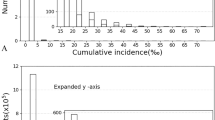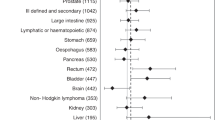Abstract
Objective: To evaluate the relationship between cumulative lifetime exposure to diagnostic radiation and the risk of multiple myeloma using data from a large, multi-center, population-based case–control study.
Methods: Study subjects included a total of 540 cases with newly diagnosed multiple myeloma and 1998 frequency-matched population controls living in three areas of the United States (Georgia, Michigan, New Jersey). Information on exposure to diagnostic X-rays was obtained by personal interview.
Results: No association was found between case–control status and the total number of reported diagnostic X-rays of any type (odds ratio (OR) for 20 or more compared to less than 5 X-rays = 0.9, 95% confidence interval (95% CI) = 0.7–1.2). There was no evidence of an excess risk of multiple myeloma among individuals who reported exposure to 10 or more diagnostic X-rays that impart a relatively high radiation dose to the bone marrow, as compared to individuals reporting no such exposures (OR 0.7, 95% CI 0.4–1.3).
Conclusions: These data suggest that exposure to diagnostic X-rays has a negligible impact, if any, on risk of developing multiple myeloma.
Similar content being viewed by others
References
Bataille R, Harrousseau J-L (1997) Multiple myeloma. N Engl J Med 336: 1657–1664.
Herrinton LJ, Demers PA, Koepsell TD, et al. (1993) Epidemiology of the M-component immunoglobulin types of multiple myeloma. Cancer Causes Control 4: 83–92.
Devesa SS (1991) Descriptive epidemiology of multiple myeloma. In: Obrams GI, Potter M, eds. Epidemiology and Biology of Multiple Myeloma. Berlin: Springer-Verlag, pp. 3–12.
Herrinton LJ, Weiss NS, Olshan AF (1998) Epidemiology of myeloma. In: Malpas JS, Bergsagel DE, Kyle RA, Anderson KC, eds. Myeloma: Biology and Management. Oxford: Oxford University Press, pp. 150–186.
Ries LAG, Eisner, MP, Kosary CL, et al., eds. (2000) SEER Cancer Statistics Review, 1973–1997. Bethesda, MD: National Cancer Institute.
Pottern LM (1991) Investigating risk factors for multiple myeloma among black and white Americans. In: Obrams GI, Potter M, eds, Epidemiology and Biology of Multiple Myeloma. Berlin: Springer-Verlag, pp. 51–53.
Andersson M, Storm HH (1992) Cancer incidence among Danish Thorotrast-exposed patients. J Natl Cancer Inst 84: 1318–1325.
Boice JD, Morin MM, Glass AG, et al. (1991) Diagnostic X-ray procedures and risk of leukemia, lymphoma, and multiple myeloma. JAMA 265: 1290–1294.
Flodin U, Fredriksson M, Persson B (1987) Multiple myeloma and engine exhausts, fresh wood, and creosote: a case-referent study. Am J Indust Med 12: 519–529.
Friedman GD (1986) Multiple myeloma: relation to propoxyphene and other drugs, radiation and occupation. Int J Epidemiol 15: 424–426.
Eriksson M (1993) Rheumatoid arthritis as a risk factor for multiple myeloma: a case-control study. Eur J Cancer 29A: 259–263.
Davis FG, Boice JD, Hrubec Z, Monson RR (1989) Cancer mortality in a radiation-exposed cohort of Massachusetts tuberculosis patients. Cancer Res 49: 6130–6136.
Boffetta P, Stellman SD, Garfinkel L (1989) A case-control study of multiple myeloma nested in the American Cancer Society prospective study. Int J Cancer 43: 554–559.
Cuzick J, De Stavola B (1988) Multiple myeloma — a case-control study. Br J Cancer 57: 516–520.
Antoku S, Russell WJ (1971) Dose to the active bone marrow, gonads, and skin from roentgenography and fluoroscopy. Radiology 101: 669–678.
Jankowski J (1984) Organ doses in diagnostic X-ray procedures. Health Phys 46: 228–234.
Shleien B, Tucker TT, Johnson DW (1978) The mean active bone marrow dose to the adult population of the United States from diagnostic radiology. Health Phys 34: 587–601.
Krain LS (1992) Some thoughts about the importance of X-ray exposure histories for patients. Med Hypotheses 37: 225–231.
Kereiakes JG, Rosenstein M (1980) Handbook of Radiation Doses in Nuclear Medicine and Diagnostie X-ray. Boca Raton, FL: CRC Press.
Bengtsson G, Blomgren PG, Bergman K, Aberg L (1978) Patient exposures and radiation risks in Swedish diagnostic radiology. Acta Radiol Oncol 17: 81–105.
SAS Institute (1990) SAS/STAT User's Guide, Version 6, 4th edn, vol. 2: The Logistie Procedure. Cary, NC: SAS Institute, pp. 1071–1126.
Baris D, Brown LM, Silverman DT, et al. (2000) Socioeconomic status and multiple myeloma among US blacks and whites. Am J Public Health 90: 1277–1281.
Graham S, Levin ML, Lilienfeld AM, et al. (1963) Methodological problems and design of the tristate leukemia survey. Ann NY Acad Sci 107: 557–569.
Preston-Martin S, Bernstein L, Maldonado AA, Henderson BE, White SC (1985) A dental X-ray validation study: comparison of interview information from patient interviews and dental charts. Am J Epidemiol 121: 430–439.
Wacholder S (1995) When measurement errors correlate with truth: surprising effects of nondifferential misclassification. Epidemiology 6: 157–161.
Dosemeci M, Stewart PA (1996) Recommendations for reducing the effects of exposure misclassification on relative risk estimates. Occup Hyg 3: 169–176.
Land CE (1980) Estimating cancer risks from low doses of ionizing radiation. Science 209: 1197–1203.
Boice JD, Land CE, Preston DL (1996) Ionizing radiation. In: Schottenfeld D, Fraumeni JF Jr, eds. Cancer Epidemiology and Prevention. New York: Oxford University Press, pp. 319–354.
Edwards M (1996) Models for estimating risk of radiation careinogenesis. In: Hendee WR, Edwards FM, eds. Health Effects of Exposure to Low-level Ionizing Radiation. Philadelphia, PA: Institute of Physics Publishing, pp. 215–235.
United Nations Scientific Committee on the Effects of Atomic Radiation (2000) Sources and Effects of Ionizing Radiation. Vol. II: Effects. New York: United Nations.
Preston DL, Kusumi S, Tomonaga M, et al. (1994) Cancer incidence in atomic bomb survivors. Part III: Leukemia, lymphoma and multiple myeloma, 1950–1987. Radiat Res 137: S68–S97.
Pottern LM, Gart JJ, Nam J, et al. (1992). HLA and multiple myeloma among black and white men: evidence of a genetic association. Cancer Epidemiol Biomarkers Prev 1: 177–182.
Author information
Authors and Affiliations
Rights and permissions
About this article
Cite this article
Hatcher, J.L., Baris, D., Olshan, A.F. et al. Diagnostic radiation and the risk of multiple myeloma (United States). Cancer Causes Control 12, 755–761 (2001). https://doi.org/10.1023/A:1011205908596
Issue Date:
DOI: https://doi.org/10.1023/A:1011205908596




